Open-source ventilator
An open-source ventilator is a disaster-situation ventilator made using a freely licensed (open-source) design, and ideally, freely available components and parts (open-source hardware). Designs, components, and parts may be anywhere from completely reverse-engineered or completely new creations, components may be adaptations of various inexpensive existing products, and special hard-to-find and/or expensive parts may be 3D-printed instead of purchased.[2][3] As of early 2020, the levels of documentation and testing of open-source ventilators was well below scientific and medical-grade standards.[4]
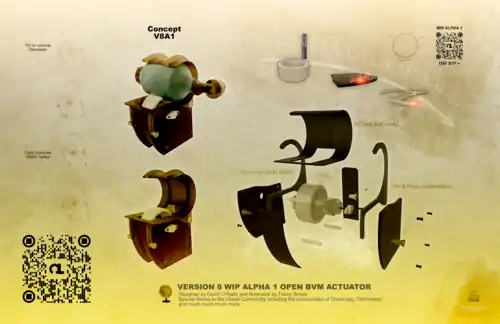
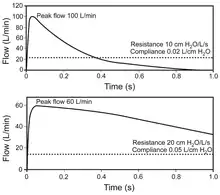
One small, early prototype effort was the Pandemic Ventilator created in 2008 during the resurgence of H5N1 avian influenza that began in 2003, so named "because it is meant to be used as a ventilator of last resort during a possible avian (bird) flu pandemic."[5]
Quality assessment
The policy of using both free and open-source software (FOSS) and open-source hardware theoretically allows community-wide peer-review and correction of bugs and faults in open-source ventilators, which is not available in closed-source hardware development. In early 2020 during the COVID-19 pandemic, a review of open-source ventilators stated that "the tested and peer-reviewed systems lacked complete documentation and the open systems that were documented were either at the very early stages of design ... and were essentially only basically tested ..." The author speculated that the pandemic would motivate development that would significantly improve the open-source ventilators, and that much work, policies, regulations, and funding would be needed for the open-source ventilators to achieve medical-grade standards.[4]
Design requirements
A number of features are required for an invasive mechanical ventilator to be safely used on a patient:[6]
- a way of measuring and controlling the volume pumped and the breath rate to avoid volutrauma;
- monitoring for inspiratory pressure, respiratory rate (bpm), and inspiratory-to-expiratory time (I/E) ratio
- for non-sedated patients, an "assist" mode that, instead of forcing air in at a fixed frequency, only increases the pressure when the patient inhales;
- for ARDS, support for setting positive end-expiratory pressure (PEEP) to avoid alveoli collapse;[7][8]
- humidification to avoid drying and cooling the alveoli.[9]
The requirements for non-invasive ventilation are less strict.
COVID-19 pandemic
The FOSS Initiative OpenVentilator.io project began on March 19, after 2 weeks of research.[10] Jeremias Almadas [11] had posted some drafts he made on the Open Source COVID-19 Medical Supplies forum.[12][13] Marcos Mendez contacted him to join efforts to develop a solution that could be reproduced on a very high scale.[14] This project later became the "OpenVentilator Spartan Model".
With the COVID-19 pandemic a new challenge had just arisen, this was no longer to manufacture ventilator, after all, these are manufactured since biblical times,[15] including since 60's models like the Bird MK VII [16] were already consolidated with an enviable engineering that is so simple .
The challenge now was to design an item that solves a problem on a global scale. Manufactured on a very large scale and with parts found in small towns and villages. These were the premises assumed by some projects like OpenVentilator.io [10]
On March 18, Medtronics had opened its code and files for manufacturing its main pulmonary ventilation equipment [17]]. The issue was on a scale that Medtronics would not be able to fulfill at the Global level, nor at the regional level. The same was already happening with Philips and G&E and Draguer, world leaders in the manufacture of this type of equipment. It would not make sense to reinvent something that had already been studying for 100 years. The problem was also not an engineering problem, but a logistical and scale problem so that these projects that were to emerge were applicable and achievable. Manufacturing should be decentralized, focused on the regional resources of each individual on planet earth. 9/10 Brazilian cities do not even have an ICU bed, let alone an electronics store and or an Ambu factory. The African situation has already announced a catastrophe [18]
Several projects are beginning to emerge in this area, many of them with an engineering approach, many others following strict validations with the regulations.
There are few projects that have an [analysis of complex thinking[19] within the [global economic-political stagnation [20]
A major worldwide design effort began during the COVID-19 pandemic after a Hackaday project was started, in order to respond to expected ventilator shortages causing higher mortality among severe patients. This project aims to build a continuous positive airway pressure device.[21]
On March 20, 2020, Irish Health Services[22] began reviewing designs.[23] A prototype is being designed and tested in Colombia.[24]
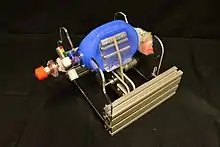
The University of Minnesota Bakken Medical Device Center initiated a collaboration with various companies to bring a ventilator alternative to the market that works as a one-armed robot and replaces the need for manual ventilation in emergency situations. The Coventor device was developed in a very short time and approved on April 15, 2020 by the FDA, only 30 days after conception. The mechanical ventilator is designed for use by trained medical professionals in intensive care units and easy to operate. It has a compact design and is relatively inexpensive to manufacture and distribute. The cost is only about 4% of a normal ventilator. In addition, this device does not require pressurized oxygen or air supply, as is normally the case. A first series is manufactured by Boston Scientific. The plans are to be freely available online to the general public without royalties.[26][27]
The Polish company Urbicum reports successful testing[28] of a 3D-printed, open-source prototype device called VentilAid. The makers describe it as a last resort device when professional equipment is missing. The design is publicly available.[29] The first Ventilaid prototype requires compressed air to run.
On March 21, 2020, the New England Complex Systems Institute (NECSI) began maintaining a strategic list of open source designs being worked on.[30][31] The NECSI project considers manufacturing capability, medical safety and need for treating patients in various conditions, speed dealing with legal and political issues, logistics and supply.[32] NECSI is staffed with scientists from Harvard, MIT, and others who have an understanding of pandemics, medicine, systems, risk, and data collection.[32]
Massachusetts Institute of Technology began an emergency project to design a low-cost ventilator that uses a bag valve mask as the main component.[25] Other groups and companies, such as Monolithic Power Systems, also developed designs based on this concept.[33]
The Oxysphere project develops open blueprints for a positive pressure ventilation hood.[34]
On April 23, 2020, NASA reported building, in 37 days, a successful COVID-19 ventilator[35] (named VITAL ("Ventilator Intervention Technology Accessible Locally") which is currently undergoing further testing. NASA is seeking fast-track approval by the United States Food and Drug Administration for the new ventilator.[36][37]
On May 29, 2020, NASA revealed the "Eight US Manufacturers Selected to Make NASA COVID-19 Ventilator."[38]
The U.S. companies selected for licenses are:
- Vacumed, a division of Vacumetrics, Inc. in Ventura, California
- Stark Industries, LLC in Columbus, Ohio
- MVent, LLC, a division of Minnetronix Medical, in St. Paul, Minnesota
- iButtonLink, LLC in Whitewater, Wisconsin
- Evo Design, LLC in Watertown, Connecticut
- DesignPlex Biomedical, LLC in Fort Worth, Texas
- ATRON Group LLC in Dallas
- Pro-Dex, Inc. in Irvine, California
Israeli engineers created an open-source ventilator [39]
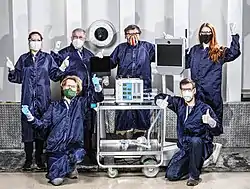
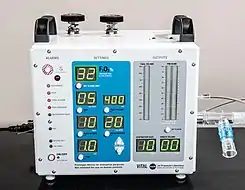
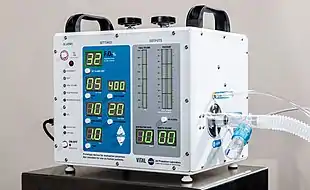
Disaster-relief provisions
On March 24, 2020, the U.S. Secretary of Health and Human Services (HHS) enacted Emergency Use Authorizations[40] to allow the use of additional devices, including: "Ventilators, positive pressure breathing devices modified for use as ventilators (collectively referred to as 'ventilators'), ventilator tubing connectors, and ventilator accessories." This was done in accordance with its February 4 declaration[41] for medical countermeasures against the coronavirus disease 2019, and the equipment is subject to the FDA's "criteria for safety, performance and labeling."
References
- "OpenLung - Open Source Ventilator / OpenLung Emergency Medical Ventilator Project / OpenLung BVM Ventilator". GitLab.
- Bender, Maddie (2020-03-17). "People Are Trying to Make DIY Ventilators to Meet Coronavirus Demand". Vice. Retrieved 2020-03-21.
- Toussaint, Kristin (2020-03-16). "These Good Samaritans with a 3D printer are saving lives by making new respirator valves for free". Fast Company. Retrieved 2020-03-17.
- Pearce, Joshua M. (2020). "A review of open source ventilators for COVID-19 and future pandemics [version 1; peer review: 1 approved]". F1000Research. 9: 218. doi:10.12688/f1000research.22942.1. Archived from the original on 2020-04-18. Retrieved 2020-04-18.
- "The Pandemic Ventilator". Instructables.com. Retrieved 2020-12-04.
- Real Engineering (4 April 2020). "A Guide To Designing Low-Cost Ventilators for COVID-19".
- Manzano, F; Fernández-Mondéjar, E; Colmenero, M; Poyatos, ME; et al. (2008). "Positive-end expiratory pressure reduces incidence of ventilator-associated pneumonia in nonhypoxemic patients". Crit Care Med. 36 (8): 2225–31. doi:10.1097/CCM.0b013e31817b8a92. PMID 18664777. S2CID 19906324.
- Pfeilsticker, FJDA; Serpa Neto, A (August 2017). "'Lung-protective' ventilation in acute respiratory distress syndrome: still a challenge?". Journal of Thoracic Disease. 9 (8): 2238–2241. doi:10.21037/jtd.2017.06.145. PMC 5594148. PMID 28932514.
- Restrepo, R. D.; Walsh, B. K. (1 May 2012). "Humidification During Invasive and Noninvasive Mechanical Ventilation: 2012". Respiratory Care. 57 (5): 782–788. doi:10.4187/respcare.01766. PMID 22546299.
- https://openventilator.io
- https://www.facebook.com/jeremias.almada
- https://www.facebook.com/groups/opensourcecovid19medicalsupplies/
- (https://www.facebook.com/search/top/?q=Open%20Source%20COVID19%20Medical%20Supplies%20jeremias%20almada&epa=SEARCH_BOX)
- https://www.linkedin.com/in/marcos-m%C3%A9ndez-7987232b/?originalSubdomain=br
- https://time.com/5815499/ventilator-history/
- https://github.com/popsolutions/openventilator/blob/master/00_Documentation/Research/Cientific/Mark%20VII.pdf
- https://www.medtronic.com/us-en/e/open-files.html
- http://www.rfi.fr/en/africa/20200403-lack-of-covid-19-treatment-and-critical-care-could-be-catastrophic-for-Africa
- pt:Edgar Morin
- https://blogs.imf.org/2020/04/14/the-great-lockdown-worst-economic-downturn-since-the-great-depression
- Coetzee, Gerrit (2020-03-12). "Ultimate Medical Hackathon: How Fast Can We Design And Deploy An Open Source Ventilator?". Hackaday. Retrieved 2020-03-17.
- Sternlicht, Alexandra. "There's A Shortage Of Ventilators For Coronavirus Patients, So This International Group Invented An Open Source Alternative That's Being Tested Next Week". Forbes. Retrieved 2020-03-21.
- Rodrigo, Chris Mills (2020-03-20). "Irish health officials to review 3D-printed ventilator". TheHill. Retrieved 2020-03-21.
- colombiareports (2020-03-21). "Colombia close to having world's first open source and low-cost ventilator to 'beat Covid-19'". Colombia News | Colombia Reports. Retrieved 2020-03-21.
- "MIT E-VENT | Emergency ventilator design toolbox". MIT E-Vent | MIT Emergency Ventilator. Retrieved 2020-03-29.
- Joe Carlson (2020-04-16). "FDA approves production of device designed at University of Minnesota to help COVID-19 patients breathe". startribune.com. Star Tribune.
- Darrell Etherington (2020-04-16). "FDA authorizes production of a new ventilator that costs up to 25x less than existing devices". techcrunch.com. Verizon Media.
- urbicum (2020-03-23). "VentilAid -open-source ventilator, that can be made anywhere locally". VentilAid. Retrieved 2020-03-23.
- urbicum (2020-03-23). "GitHub - VentilAid / VentilAid". VentilAid. Retrieved 2020-03-23.
- Fenton, Bruce (March 21, 2020). "Ventilator Project Update: March 21th, 2020". Medium. Retrieved March 27, 2020.
- "A list projects to make emergency ventilators in response to COVID-19, focusing on free-libre open source". GitHub. Retrieved March 27, 2020.
- Fenton, Bruce (March 14, 2020). "We need Ventilators - We Need You to Help Get Them Built". Medium. Retrieved March 27, 2020.
- "MPS Open-Source Ventilator". monolithicpower.com. Retrieved 2020-04-29.
- "Oxysphere – OpenHardware Ventilation Project – Let us Stop Covid together". Archived from the original on 2020-05-13. Retrieved 2020-03-31.
- "Nasa Developed a Super Ventilator for Covid-19 Patients". AllBlogThings.com - A Tech & Business Blog!. Retrieved 2020-04-30.
- Good, Andrew; Greicius, Tony (23 April 2020). "NASA Develops COVID-19 Prototype Ventilator in 37 Days". NASA. Retrieved 24 April 2020.
- Wall, Mike (24 April 2020). "NASA engineers build new COVID-19 ventilator in 37 days". Space.com. Retrieved 24 April 2020.
- "Eight US Manufacturers Selected to Make NASA COVID-19 Ventilator". NASA Jet Propulsion Laboratory (JPL). Retrieved 2020-06-02.
- https://qz.com/1836451/israeli-team-creates-open-source-hack-for-making-covid-19-ventilators/
- Health, Center for Devices and Radiological (April 6, 2020). "Emergency Use Authorizations". FDA – via fda.gov.
- "Notice of Declaration under the Public Readiness and Emergency Preparedness Act for medical countermeasures against COVID-19". Department of Health and Human Services Office of the Secretary".
External links
- HackerNoon article featuring four open source ventilator projects.
- An overview of open source ventilator initiatives and open regulatory standards.
- Open Source Ventilator community and other COVID supplies, with 2000+ members; 8th design iteration as of March 26.
- The OpenVentilator.Io Spartan Model
- Opensource against covid19.
- Development status, concept and features comparison for open source ventilators projects in a single table.
- Open-source ventilator design, Vanderbilt University
- 7 open hardware projects working to solve COVID-19.
- Open Source Against COVID-19
- Open Source COVID19 Medical Supplies
- OxyGEN Project (ed.). "Emergency ventilator for COVID-19 crisis approved by the Spanish medicine agency". Retrieved 2020-04-13.
- Automation of Bag-Valve-Mask (BVM) using arms and servo-motors.
- Garmendia, Onintza; Rodríguez-Lazaro, Miguel A.; Otero, Jorge; Phan, Phuong; Stoyanova, Alexandrina; Dinh-Xuan, Anh Tuan; Gozal, David; Navajas, Daniel; Montserrat, Josep M.; Farré, Ramon (2020-01-01). "Low-cost, easy-to-build non-invasive pressure support ventilator for under-resourced regions: open source hardware description, performance and feasibility testing". European Respiratory Journal. 55 (6): 2000846. doi:10.1183/13993003.00846-2020. ISSN 0903-1936. PMC 7173672. PMID 32312862. Retrieved 2020-04-21.
